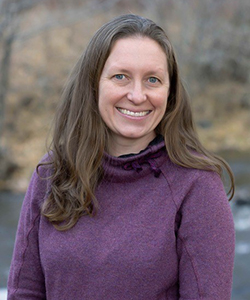Contact Us




Chemical and Biomedical Engineering
EN 4055
Dept. 3295
1000 E. University Ave.
Laramie, WY 82071
Phone: (307)766-2500
Email: che-info@uwyo.edu
CHEMICAL and Biomedical ENGINEERING
COLLEGE OF ENGINEERING AND Physical Sciences
Karen Wawrousek
Associate Professor and ABET Coordinator
Room 4029, Engineering Building
University of Wyoming
College of Engineering and Physical Sciences
Department of Chemical and Biomedical Engineering
Dept. 3295
1000 E. University Avenue
Laramie, WY 82071
kwawrous@uwyo.edu
Phone: 307.766.5409
Molecular and Cellular Life Sciences Program Faculty Member

Experience
- Lead Scientist, Waste & Environmental Management, Western Research Institute, 2012-2014
- Postdoctoral Scientist, Photobiology, National Renewable Energy Laboratory, 2010-2011
- Ph.D. Biochemistry & Molecular Biophysics, California Institute of Technology, 2001-2009
Research Areas
- Synthetic biology and genetic engineering of non-model bacteria for the production of fuels and chemicals
- Microbial communities in extreme environments
- Diagnostic assay development.
Research Interests
My group is interested in the use of non-model bacteria to make fuels and chemicals from inexpensive by-products or wastes. A recent project focuses on the use of Rhodococcus opacus for the upgrading of an agricultural by-product to biodiesel precursors, and the group has previously investigated the use of non-model microbes for the production of fuels (hydrogen and biodiesel precursors), as well as commodity chemicals. It is through this research using non-model microbes that we became interested in microbial communities in extreme environments, and we have several on-going studies on microbial communities in the deep subsurface.
Prior to the Covid-19 pandemic, my group had started to work on the development of a novel biomedical diagnostic assay. During the Covid-19 pandemic, we shifted our focus to develop sensitive, specific novel Covid-19 diagnostics.
Select Publications
- Antoine, M. Mohammadi, C. McDermott, E. Walsh, P. Johnson, K. Wawrousek, J. G. Wall, “Isolation of SARS-CoV-2-blocking recombinant antibody fragments and characterisation of their binding to variant spike proteins,” Frontiers in Nanotechnology, 2022. Sec. Biomedical Nanotechnology.
- Coyle and K. Wawrousek, “Rhodococcus opacus PD630 Bioconversion of Molasses Desugarized Solubles for Fatty Acid Production” Industrial Biotechnology, 2022, Volume 18, Issue 6, 358-365.
- Mohammadi, B. Reinicke, K. Wawrousek, “Biosorption and Biomagnetic Recovery of La3+ by Magnetospirillum magneticum AMB-1 Biomass” Separation and Purification Technology, 2022, Volume 303, 122140.
- Mohammadi, D. Antoine, M. Vitt, J. Dickie, S. Sultana Jyoti, J. G. Wall, P. Johnson, K. Wawrousek, “A Fast, Ultrasensitive SERS Immunoassay to Detect SARS-CoV-2 in Saliva” Analytica Chemica Acta. 2022, 1229, 340290.
- Antoine1, M. Mohammadi1, J. Dickie, S. Sultana Jyoti, M. A. Tilbury, M. Vitt, P. A. Johnson, K. Wawrousek2, J. G. Wall2, “A rapid, point-of-care scFv-SERS assay for femtogram level detection of SARS-CoV-2” ACS Sens.2022, 7, 3, 866–873.
1 co-first authors
2 co-corresponding authors
- C. Eckert, E. Freed, K. Wawrousek, S. Smolinski, J. Yu, P.-C. Maness, “Inactivation of the Uptake Hydrogenase in the Purple Non-Sulfur Photosynthetic Bacterium Rubrivivax gelatinosus CBS Enables a Biological Water-Gas Shift Platform for H2 Production” Journal of Industrial Microbiology & Biotechnology. 2019 Jul;46(7):993-1002.
- K. Wawrousek, S. Noble , C. Eckert, J. Korlach, J. Chen, J. Yu, P.-C. Maness, “Genome Annotation Provides Insight into Carbon Monoxide and Hydrogen Metabolism in Rubrivivax gelatinosus CBS.” PLoS One. 2014. Dec 5;9(12):e114551.
- A. Bland, T. Zhang, K. Wawrousek, “WRI’s CAT Process: Development and Deployment of Clean Synthetic Transportation Fuels Via Carbon Emissions Capture/Re-Use Technology.” American Coal. Jan. 2013.
- P. Hu, J. Lang, K. Wawrousek, J. Yu, P.-C. Maness, J. Chen, “Draft Genome Sequence of Rubrivivax gelatinosus CBS.” J. Bacteriol. 2012 194(12):3262.
- D. Carrieri, K. Wawrousek, C. Eckert, J. Yu, P.-C. Maness, “The Role of the Bidirectional Hydrogenase in Cyanobacteria.” Bioresource Technology. 2011 15;9(6):1156-66.
Patents
- K. Wawrousek, P. Richards, A. Bland “Biological Methods and Systems for Coal-to-Biofuels and Bioproducts.” (US patent 10,557,155, granted Feb. 2020)
- K. Wawrousek, P. Richards, T. Zhang, A. Bland, “Systems and Methods for Conversion of Carbon Dioxide Utilizing Chemoautotrophic Microorganisms.” (US patent 10,376,837, granted August 2019)
- K. Stahlfeld, K. Wawrousek, E. Belmont, “Production of Fatty Acids from Agricultural Waste via Non-Photosynthetic Microbe” (provisional patent submitted Fall 2017)
- K. Wawrousek, C. Eckert, P.-C. Maness, J. Yu, “Biological Catalyst for Water Gas Shift Reaction” (provisional patent submitted Spring 2017)
Contact Us




Chemical and Biomedical Engineering
EN 4055
Dept. 3295
1000 E. University Ave.
Laramie, WY 82071
Phone: (307)766-2500
Email: che-info@uwyo.edu
